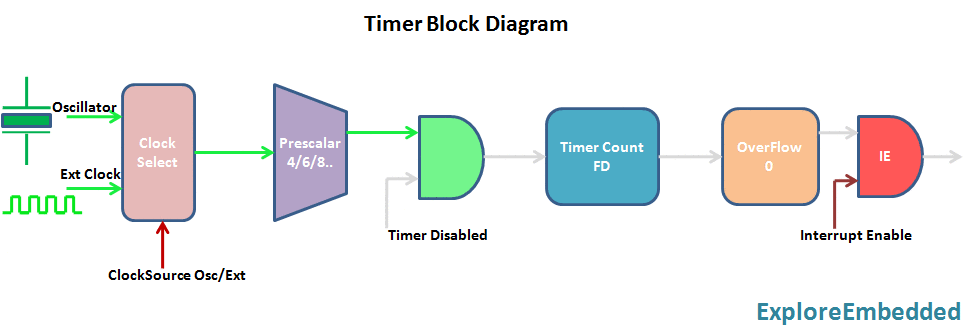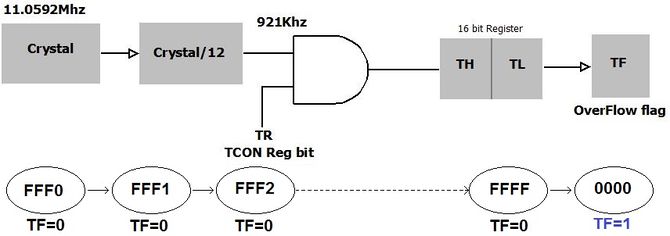Difference between revisions of "5.8051 Timer programming"
| Line 24: | Line 24: | ||
|TIMER2(8052 only)|| 16-bit || TMOD,TCON|| TH1,TL1 || 0.2usec || 104.857ms | |TIMER2(8052 only)|| 16-bit || TMOD,TCON|| TH1,TL1 || 0.2usec || 104.857ms | ||
|}<br> | |}<br> | ||
| + | |||
| + | =Timer Calculation= | ||
| + | PIC Oscillator frequency is divided by 4 and then fed to the controller, Now this this freq can be further divided by presacalar to generate the range of delays.<br> | ||
| + | Time to increment the Timer count by one(timer tick) can be determined as below. <br> | ||
| + | tick = (Prescalar/(Fosc/4)<br> | ||
| + | tick = (Prescalar/(20Mhz/4))<br> | ||
| + | $$tick = (Prescalar * 4)/Fosc$$ | ||
| + | |||
| + | Now the Timer value for the required delay can be calculated as below.<br> | ||
| + | Delay = TimerCount * tick<br> | ||
| + | Count = (Delay/tick)<br> | ||
| + | RegValue = TimerMax- Count <br> | ||
| + | RegValue = TimerMax-(Delay/tick) = TimerMax - (Delay/((Prescalar *4)/Fosc))<br> | ||
| + | $$RegValue = TimerMax-((Delay * Fosc)/(Prescalar*4))$$ | ||
=Video Tutorial= | =Video Tutorial= | ||
Revision as of 11:58, 22 August 2016
In this tutorial, we are going to discuss the Timer module of 8051.
First, we will see what are timers, their working and later we will configure the 8051 timers to generate the delay of 100ms and 500ms respectively. At the end, we will see how to use the ExploreEmdedded Timer library.
Contents
[hide]Timer Basics
As the name suggests these are used to measure the time or generate the accurate time delay. The microcontroller can also generate/measure the required time delays by running loops, but the timer/counter relieves the CPU from that redundant and repetitive task, allowing it to allocate maximum processing time for other tasks.
The timer is nothing but a simple binary counter that can be configured to count clock pulses(Internal/External). Once it reaches the Max value, it will roll back to zero setting up an OverFlow flag and generates the interrupt if enabled.

8051 Timer Module
8051 has two indepenndent timer which can be used as timer,Counters.
Below table provides the details of the 8051 Timers.
| Timer | Size | Control Register | Count Register | Min Delay | Max Delay |
|---|---|---|---|---|---|
| TIMER0 | 16-bit | TMOD,TCON | TH0,TL0 | 0.2usec | 13.107ms |
| TIMER1 | 16-bit | TMOD,TCON | TH1,TL1 | 0.2usec | 104.857ms |
| TIMER2(8052 only) | 16-bit | TMOD,TCON | TH1,TL1 | 0.2usec | 104.857ms |
Timer Calculation
PIC Oscillator frequency is divided by 4 and then fed to the controller, Now this this freq can be further divided by presacalar to generate the range of delays.
Time to increment the Timer count by one(timer tick) can be determined as below.
tick = (Prescalar/(Fosc/4)
tick = (Prescalar/(20Mhz/4))
$$tick = (Prescalar * 4)/Fosc$$
Now the Timer value for the required delay can be calculated as below.
Delay = TimerCount * tick
Count = (Delay/tick)
RegValue = TimerMax- Count
RegValue = TimerMax-(Delay/tick) = TimerMax - (Delay/((Prescalar *4)/Fosc))
$$RegValue = TimerMax-((Delay * Fosc)/(Prescalar*4))$$
Video Tutorial
Timer Basics
Generating 50ms Delay with Timer 0, Mode 1
In this tutorial we will see 8051 timers. We will use the 8051 timers to generate a precise delay of 50 milli sec.
8051 timers/counters
The 8051 has 2 timers/counters.
- They can be used to generate precise timing, i.e., we can measure time between events. The unit is then called timer.
- It can also be used to count external events, known as counter.
- Timer 1 is also used for generating baud rate in serial communication, which we will discuss in the next tutorial
Timer Operation
The 8051 timer and counter is the same unit, but in this tutorial we will discuss only the timer unit to simplify the discussion.
Timer Tick
- The C/Ṫ = 0 bit of TMOD register selects operation of Timer/counter unit as timer.
- The TR bit of TCON register is used to start the timer.
Timer Registers
Timer Register T0/T1
| T0 | |||||||||||||||
|---|---|---|---|---|---|---|---|---|---|---|---|---|---|---|---|
| TH0 | TL0 | ||||||||||||||
| D15 | D14 | D13 | D12 | D11 | D10 | D9 | D8 | D7 | D6 | D5 | D4 | D3 | D2 | D1 | D0 |
TMOD Register
| M1 | M0 | Operation |
|---|---|---|
| 0 | 0 | 13 bit Timer |
| 0 | 1 | 16 bit Timer |
| 1 | 0 | 8 bit Auto Reload |
| 1 | 1 | Split Mode |
| TMOD | |||||||
|---|---|---|---|---|---|---|---|
| D7 | D6 | D5 | D4 | D3 | D2 | D1 | D0 |
| Gate | C/T | M1 | M0 | Gate | C/T | M1 | M0 |
| Timer1 | Timer 0 | ||||||
TCON Register
| TCON | |||||||
|---|---|---|---|---|---|---|---|
| D7 | D6 | D5 | D4 | D3 | D2 | D1 | D0 |
| TF1 | TR1 | TF0 | TR0 | IE1 | IT1 | IE0 | IT0 |
| Timer1 | Timer 0 | Interrupts | |||||
Timer Example
- #include<reg51.h>
- void delay_t0(void);// function prototype
- void delay_t0()
- {
- TMOD = 0x01; //Timer zero mode 1
- TH0 = 0X4B;
- TL0 = 0XFF;
- TR0 = 1; //turn ON Timer zero
- while(TF0 == 0);
- TF0 = 0; //clear the timer
- TR0 = 0;
- }
- void main()
- {
- P3 = 0x00; //set port as output
- while(1)
- {
- P3 = 0XFF;
- delay_t0();
- P3 = 0X00;
- delay_t0();
- }
- }
{{#seo: |title=8051_Timers |titlemode=append |keywords=8051,AT89s51,at89c51,p89v51rd2,XploreLabz,Timer,Timers,8051 timers/counters,8051 timer operation,8051 Timer registers,TMOD Register,TCON register |description=8051 Timers }} Would like to have your feedback and suggestions here;






